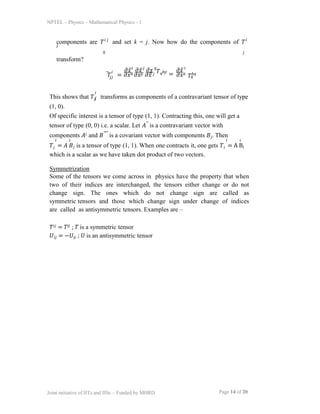lec28.ppt
- 1. NPTEL ‚Äì Physics ‚Äì Mathematical Physics - 1 Lecture 28 Algelraic properties of tensors Like vectors, the tensors obey certain operations which are: a) Addition If T and S are two tensors of type (r, s), then their sum U = T + S is defined as ùëàùëó1‚Ķ‚Ķ‚Ķ‚Ķ‚Ķ‚Ķ ùëó ùë† ùëñ1‚Ķ‚Ķ‚Ķ‚Ķ..ùëñùëü = ùëáùëñ1‚Ķ‚Ķ..ùëñùëü + ùëÜùëñ1‚Ķ‚Ķ..ùëñ ùëü ùëó 1‚Ķ‚Ķ‚Ķùëó ùë† ùëó 1‚Ķ‚Ķ‚Ķùëó ùë† Thus U is also a tensor of type (r, s), which can be easily proved by showing the transformation property, ùëàÃÖùëñ1‚Ķ‚Ķ‚Ķ‚Ķ..ùëñùëü = ùúïùë•ÃÖ ùëó 1‚Ķ‚Ķ‚Ķ‚Ķ‚Ķ‚Ķùëó ùë† ùúïùë•‚Ñé1 ùëñ1 ùëñ ùëü ùúïùë•ÃÖ ùúïùë• ‚Ķ ‚Ķ ‚Ķ ùúïùë•‚Ñéùëü ùúïùë•ÃÖ ùëó1 ‚Ķ ‚Ķ ‚Ķ ùúïùë•ÃÖ ùëóùë† ùëò1 ùúïùë•ùëòùë† ùëà‚Ñé1‚Ķ‚Ķ‚Ķ‚Ķ..‚Ñéùëü Page 13 of 20 Joint initiative of IITs and IISc ‚Äì Funded by MHRD ùëò1‚Ķ‚Ķ‚Ķ‚Ķ‚Ķ‚Ķùëò ùëü b) Multiplication If T is a tensor of type (ùëü1, ùë†1) and S is a tensor of type (ùëü2, ùë†2), then the product U = T ‚äó S, defined component wise as, ùëàùëó 1‚Ķ‚Ķ‚Ķ‚Ķ‚Ķ‚Ķ ùëó ùë†1+ùë†2 ùë†1 1 ùë†1+ùë†2 ùëñ1‚Ķ‚Ķ‚Ķ‚Ķ..ùëñùëü 1+ùëü 2 = ùëá ùëñ1‚Ķ‚Ķ‚Ķ‚Ķ..ùëñùëü 1 ùëÜ ùëñùëñùëü 1+1 ‚Ķ‚Ķ‚Ķ‚Ķ..ùëñùëü 1+ ùëü 2 ùëó 1‚Ķ‚Ķ‚Ķ‚Ķ‚Ķ‚Ķùëó ùëó ùë† +1‚Ķ‚Ķ‚Ķ‚Ķ‚Ķ‚Ķ ùëó Which is a tensor of type (ùëü1 + ùëü2, ùë†1 + ùë†2). For example, if T is a tensor of type ùëñ ùëíùëö (1,2) with components ùëáùëó ùëò and S is a tensor type (2,1) with components ùëÜùëö , then the components of the tensor product U as, ùëàùëóùëôùëö ùëóùëò ùëõ and they transform according to the rules, ùëñùëôùëö = ùëáùëñ ùëÜùëô ùëö ùëà ÃÖ ùëó ùëôùëö ùëó ùëò ùëõ ùëñùëô ùëö = ùëá ùëÜ = ÃÖ ÃÖ ùëñ ùëôùëö ùúï ùúïùë• ùëÜùë° ùëüùë† The above shows that U is a tensor of rank (3, 3). c) Contraction The contraction is defined by the following operation ‚Äì given by a tensor type (r, s), take a covariant index and set it equal to a contravariant index, that is, sum over those two indices. It will result in a tensor of type (r-1, s-1). An example will make it clear. Take a tensor of type (2, 1) whose ùë•ÃÖ ùëñ ùúïùë• ùëù ùúïùë•2 ùúïùë•ÃÖ ùëô ùúïùë•ÃÖ ùëö ùúïùë•ùë° ùëñ ‚Ñé ùúïùë•ÃÖ ùëó ùúï ùë•ÃÖ2 ùëáùëóùëò ùúïùë•ùëü ùúïùë•ùë† ùúï ùë•ùëõ
- 2. Page 14 of 20 Joint initiative of IITs and IISc ‚Äì Funded by MHRD NPTEL ‚Äì Physics ‚Äì Mathematical Physics - 1 components are ùëáùëñ ùëó and set k = j. Now how do the components of ùëáùëñ ùëó ùëò ùëó transform? ùëá = ÃÖ ùëó ùëñ ùëó ùúïùë•ÃÖ ùúïùë•ÃÖ ùúïùë• ‚Ñéùëù = ùúïùë•ÃÖ ùëñ ùëó ùëû ùëñ ùúïùë•ùëõ ùúïùë•ùëù ùúïùë•ÃÖ ùëó ùëáùëû ùúïùë•‚Ñé ùëá‚Ñéùëû ùëû This shows that ùëáùëó transforms as components of a contravariant tensor of type (1, 0). Of specific interest is a tensor of type (1, 1). Contracting this, one will get a tensor of type (0, 0) i.e. a scalar. Let ùꥂÉë is a contravariant vector with components ùê¥ùëñ and ù굂Éó‚Éë is a covariant vector with components ùêµùëó. Then ùëáùëó = ùê¥ ùêµùëó is a tensor of type (1, 1). When one contracts it, one gets ùëáùëñ = A Bi which is a scalar as we have taken dot product of two vectors. ùëñ ùëó ùëñ ùëñ ùëñ i Symmetrization Some of the tensors we come across in physics have the property that when two of their indices are interchanged, the tensors either change or do not change sign. The ones which do not change sign are called as symmetric tensors and those which change sign under change of indices are called as antisymmetric tensors. Examples are ‚Äì ùëáùëñùëó = ùëáji ; ùëá is a symmetric tensor ùëàùëñùëó = ‚àíùëàji ; ùëà is an antisymmetric tensor


